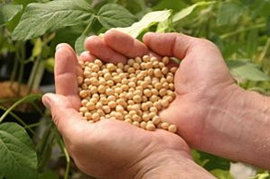 ports, which more than tripled from 2004 to 59.2 million metric tons in the year to Sept. 30, will probably fall to 58 million tons this year, according to the median of a Bloomberg survey of four crushers and three analysts in China.
ports, which more than tripled from 2004 to 59.2 million metric tons in the year to Sept. 30, will probably fall to 58 million tons this year, according to the median of a Bloomberg survey of four crushers and three analysts in China.China’s 35 cases of H7N9 flu virus infections and 10 deaths are raising the specter of the 2003 global pandemic of severe acute respiratory syndrome that killed 774 people.
Imports of soybeans plunged 21 percent in the 2003-2004 marketing year and an outbreak of H5N1 virus in 2006 also led to the slowest growth in shipments since the SARS outbreak.
“We believe this new avian flu will cut at least 500,000 tons of soybean-meal demand in the immediate future,” said Liu Xianwu, general manager at researcher China Cereals & Oils Business Net.
“Soybeans will come down because at the current level, Chinese crushers don’t make money,” he said April 12.
Soybeans in Chicago may drop to $13 a bushel in the next month, according to Beijing-based China Cereals.
Soybeans for May on the Chicago Board of Trade delivery were at $13.7625 a bushel at 3:37 p.m. in Beijing on April 12.
Meal on the Dalian Commodity Exchange closed at 3,157 yuan ($510) a ton on April 12, losing 6.8 percent since March, when the outbreak was first reported.
Husbandry ‘Disasters’
“Disasters are hitting the animal husbandry one wave after another,” as even before the bird flu, consumers were still leery of eating pork from the effect of the dead hogs incident, said Monica Tu, soybean analyst at Shanghai JC Intelligence Co.
“It’s looking more likely we’ll have to keep cutting projection for this year’s imports,” she said.
Yum! Brands, Inc. said in a statement this week that the avian flu in China has had a “significant, negative impact on KFC sales.”
Xiamen Airlines Co. has suspended serving chicken or ducks because of passengers’ concerns.
Authorities in Shanghai retrieved 11,040 dead pigs from Shanghai’s Huangpu river last month, with thousands more found in neighboring Zhejiang province.
The environmental scare helped reduce the price of live hogs to the lowest in almost three years, causing “large losses” to the nation’s animal husbandry sector, Liu Yonghao, chairman of New Hope Liuhe Co., China’s biggest poultry supplier, said in Beijing on April 9.
The average price of live hogs traded in northern Shandong province declined to 12.20 yuan a kilogram on April 12, the lowest since July 2010, according to Shanghai JC data.
China used 45.2 million tons of soybean meal to feed animals in 2011-2012, according to Shanghai JC’s Tu.
Hogs account for about half of the feed consumption, while the poultry and eggs sector took 40 percent, Tu said. Feed is made mostly with soybean meal, corn and sometimes wheat.
Total soybean imports in the first six months of the 2012- 2013 marketing year fell 9.2 percent.
Read the full article





